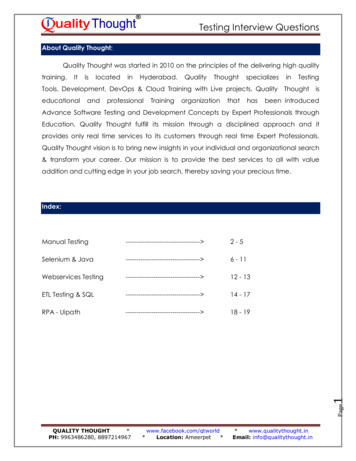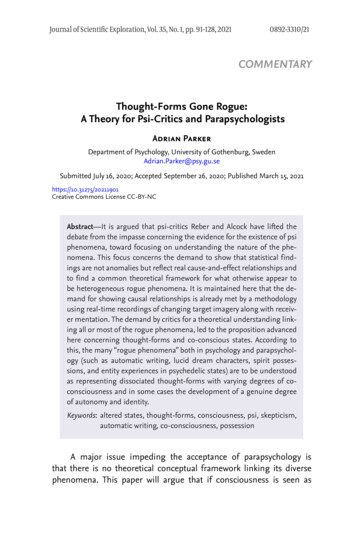
Transcription
Thought LeadersConnected HomesThought LeadersPierre DanonBTSteve DavidPROCTER & GAMBLEKei-ichi EnokiNTT DOCOMOAshley HighfieldBBCDavid HulbertWALT DISNEYTim KellyINTERNATIONALTELECOMMUNICATION UNIONSanghoon LeeEssays from innovatorsEdited by Fernando Gil de Bernabé y VarelaEdited by Fernando Gil de Bernabé y VarelaThe communications industry is undergoing massive change,and nowhere is that more evident than in the arena of consumerbroadband. Virtually every service provider is attempting to capturethis still-nascent but exploding market – from incumbents, alternativeservice providers, and cable and satellite operators to mobile andInternet portals. This selection of essays provides a look at the forcesthat are shaping the consumer broadband market, with the goal ofhelping service providers adapt to and profit from this opportunity.Editor, Fernando Gil de Bernabé, reveals a coherent picture of theconsumer broadband market, sensing the pulse of different keyplayers in the industry, and providing insight and pragmatic viewson how to succeed in this rapidly growing marketplace. ConnectedHomes contains views and vision from some of the most innovativePaul Liaoexecutives and leading thinkers around the world. Essays cover theKeiichi MakizonoSOFTBANK BBForrest MillerSBC COMMUNICATIONS INC‘connected’ home and consumer; the challenge of diversification intocontent and advanced communication services; how to monetisebroadband services; and visionary examples of what is out there,beyond broadband.Johannes MohnBERTELSMANN AGAndrew OdlyzkoUNIVERSITY OF MINNESOTAAldo OlivariTELECOM ITALIASilvio ScagliaE.BISCOMHoward WatsonTELEWEST COMMUNICATIONS PLCJeff WeberSBC OPERATIONS INCZhang Jia HuaCHINA TELECOMJong-Lok YoonKOREA TELECOMPrice 9.99 15.00 19.00Edited by Fernando Gil de Bernabé y VarelaKOREA TELECOMPANASONIC TECHNOLOGIESConnected HomesBill BodinIBM & INTERNET HOME ALLIANCEEssays from innovators
PublisherPremium PublishingT: 44 (0)7974 17 67 08www.premiumpublishing.co.ukDesignLoman Street Studiowww.lomanstreetstudio.comPrintG&B PrintersT: 44 (0)20 8755 1822
Thought LeadersEssays from innovatorsEdited by Fernando Gil de Bernabé y VarelaConnectedHomes
The Cisco Systems Internet Business Solutions Group (IBSG) helps customers transform theirinstitutions, organisations, and businesses; create new services; and drive industry-leading changethrough the use of technology and process innovation. IBSG consultants offer a uniquecombination of in-depth industry, business and technical knowledge.IBSG’s Global Service Provider Practice provides trusted, independent advice to senior businessexecutives from some of the world’s largest telecom service providers. IBSG helps customersimprove their business through innovative programs and approaches that target both new revenuegeneration and operational expenditure reduction. The Service Provider Practice consists of a teamof seasoned advisors drawn from the industry and the major management consulting firms.Published byPremium Publishing27 Bassein Park RoadLondonW12 9RWcrestanorris@btconnect.comFirst published 2004Reprint with additional material 2004Copyright 2004 Premium PublishingThe moral rights of the authors have been asserted.All rights reserved.Without limiting the rights under copyright reservedabove, no part of this publication may be reproduced,stored or introduced into a retrieval system ortransmitted in any form or by any means withoutthe prior knowledge and written permission of thecopyright owner and the above publisher of the book.ISBN 0-9546445-6-5Many thanks to the interviewers: Marco Nicosia,Michael Rabinowitz, Phil Smith, Steven Ying, PastoraValero, Aarti Gurnani, Jimmy Sartain, David Gordon,Robbert Kuppens, Ramon Talboo, Vishrut Patel, TonyBarra, Kristine Stewart, Neville Wheeler, HirokazuNishikado, Cresta Norris. And to executive sponsors:Toby Burton, Bill BrownellSpecial thanks to the Internet Home AllianceEdited by Fernando Gil de Bernabé y VarelaDesign by Loman Street StudioCover images by Getty ImagesPrinted by G&B printersA catalogue record for this book is available fromthe British Library
Contents1IntroductionFernando Gil de Bernabé y Varela, Managing Director for Service Providers, IBSG, EMEA, Cisco Systems IncSECTION 1: CONNECTED HOME, CONNECTED CONSUMER20Technology to suit our lifestyle: where work and leisure are not a placeBill Bodin Chief Technology Officer, Internet Home Alliance, and Senior Technical Staff Member, IBM, USA28Aldo Olivari CEO, Telecom Italia Lab, Italy441.2Consumers take the leadSteve David Chief Business-to-Business Officer, Procter & Gamble, USA501.1The connected home: a look into the future1.3Taking ideas from life to create lifePaul Liao President, Panasonic Technologies, Matsushita, USA1.4SECTION 2: CONTENT VS COMMUNICATIONS58Finding a voice: learning from historyAndrew Odlyzko Director, Interdisciplinary Digital Technology Center, University of Minnesota, USA66Broadband without the hypeDavid Hulbert President, Walt Disney TV International, UK742.2A paradigm shift for content distributionJohannes Mohn Executive Vice-President, Media Technology, Bertelsmann AG, Germany782.12.3A broadcast strategy for an online worldAshley Highfield Director, BBC New Media and Technology, UK2.4SECTION 3: MAKING MONEY IN BROADBAND84Evolution of IP enabled communication servicesForrest E Miller Group President, External Affairs & Planning, SBC Communications Inc, USAJeffrey G Weber Vice-President, Product & Strategy, SBC Operations Inc, USA88Leaping the chasm from connection to powerful enablerPierre Danon CEO, BT Retail, UK943.3Korea: hands-down winner in the world broadband raceJong-Lok Yoon CTO, Korea Telecom, Republic of Korea1043.2Broadband: the catalyst of integrationHoward Watson CTO and Managing Director, Networks, Technology & IT, Telewest UK1003.13.4China Telecom: moving forward in the value chainZhang Jia Hua Managing Director, Product Development Division, China Telecom, China3.5
ContentsSECTION 4: BEYOND BROADBAND1144.1How FastWeb is setting the pace: a broadband success storySilvio Scaglia Founder and Chairman, e.Biscom, Italy1204.2Surviving as a winner in Japan: Yahoo! BB’s strategy for becoming number oneKeiichi Makizono Head General Manager, Main Technology Division, Softbank BB1324.3Beyond broadband: KT’s Internet broadband serviceSanghoon Lee Executive Vice-President, Network Group, Korea Telecom, Republic of Korea1404.4Frequency: the most important resource for NTT DoCoMoKei-ichi Enoki Executive Vice-President, Managing Director, i-mode Business, NTT DoCoMo, Japan1484.5The broadband revolution: translating vision into actionTim Kelly Head of the Strategy and Policy Unit, International Telecommunication Union, SwitzerlandINFORMATION157Author biographies
Introduction
2 CONNECTED HOMESConsumer broadband:the path to growth and profitability*Fernando Gil de Bernabé y Varela Managing Director for ServiceProviders, Internet Business SolutionsGroup, EMEA, Cisco Systems, IncThe communications industry is undergoing massive change, andnowhere is that more evident than in the arena of consumerbroadband. Virtually every service provider is attempting to capturethis still-nascent but exploding market – from incumbents, alternativeservice providers, and cable and satellite operators to mobile andInternet portals. This selection of essays provides a look at the forcesthat are shaping the consumer broadband market, with the goal ofhelping service providers adapt to and profit from this opportunity.This book takes a snapshot of the consumer broadband market in2004, sensing the pulse of different key players in the industry, andproviding insight and pragmatic views on how to succeed inbroadband. The book contains views and advice from some of themost innovative executives and leading thinkers around the worldand from different participants in the value chain of consumerbroadband. The book is structured into four sections with essays thatcover the ‘connected’ home and consumer; the challenge ofdiversification into content and/or into advanced communicationservices; how to monetise broadband; and some examples of what isbeyond broadband access.Broadband is the futureMost residential customers are still using a dial-up connection to accessthe Internet. With the notable exception of South Korea, where an1.Ovum South Korea BroadbandSnapshot, January 2004.estimated 75 per cent of households have high-speed connections1,the consumer broadband market is still in its infancy, with penetration rates inthe US just slightly above 20 per cent, while Europe as a whole averages only2.Point Topic, April 2004; Goldman15 per cent2.Sachs Investment Research,April 2004; Company data;Cisco IBSG analysis.Consumer broadband provides one of the biggest and best opportunities forservice providers of all types – incumbents, alternative, cable and mobile – toincrease revenues and profitability. Europe and the US are expected to reachCompany data,an average household penetration rate of more than 60 per cent by 2010 3.Cisco IBSG analysis.This is good news at a time when revenues from traditional voice services are3.flat or declining and the ability of the telecommunications industry to evengrow is being questioned.Consumer broadband does have its challenges. Opportunities for growth areoften accompanied by threats to current revenue streams. While consumer
INTRODUCTION 3*Note: this essay is an abstract of theCisco IBSG white paper on Consumer Broadband availableat http://www.cisco.com/go/consumerbroadbandbroadband offers traditional telecommunication service providers the chanceto enter the video distribution business, it also allows cable service providersto compete in the voice market. Broadband allows service providers toapproximately double the average revenue per user (ARPU) in access whencompared to traditional dial-up4, but it also provides consumers with the4. ARPU Westernopportunity to consolidate multiple lines for fax, voice and Internet accessBB Internet access of 362 by end ofonto a single broadband line. Already, service providers are seeing once lucrativevoice revenues erode as consumers start moving to Voice Over IP (VoIP). In AsiaEurope on2003, versus ARPU of 185 on dialInternet access. IDC European BBForecasts, April 2004.alone (excluding Japan) consumer VoIP revenues reached 1.7 billion in 2003and are forecast to reach 3.4 billion by 20075. And cable service providers and5.incumbents alike will soon face competition from pure IP-based service providersForecast 2004.IDC APAiC VoIP Servicessuch as Yahoo!, Broadband (BB) in Japan, FastWeb in Italy and B2 in Sweden.Faced with these challenges, some service providers proceed cautiously, rollingout consumer broadband only when it doesn’t endanger their currentbusinesses. Some see broadband as simply a bad business to be in. One seniorexecutive of a large European telco was heard to say in 2002 that, ‘We allknow that it (broadband access) is unprofitable!’6 Many see broadband simply6.as an opportunity to defend their traditional voice revenues. Others are keepingSeptember 2003.Ovum Financial Prospects for DSL,broadband prices high, effectively slowing its adoption.But this go-slow approach is often a mistake. Consumer broadband can be avery profitable business, but only if it is fully embraced. Consumer broadbanddrives the migration to a full IP network, and is the best reason serviceproviders have to adopt a much-needed approach to their business. Thesooner service providers migrate to a full IP network with broadbandconnections – ‘broadband dialtone’ – for every customer, the sooner thesecompanies will be on a sustainable path to growth and profitability, becomingin the process a new kind of company: the service provider of the future.Competing in consumer broadband is not a simple task. It requires companiesto make hard choices about which segments to target, what services tooffer first, how to evolve the business model, and how to change theirown organisation to operate and compete more efficiently. ShouldCredits and acknowledgements:Core members of the CiscoConsumer Broadband Initiativetelecommunications service providers focus their efforts on providing(the 16 month study that this essayadvanced broadband-enabled communications services, or should theyis based on in no particular order):branch out into the content business and compete directly with cable firms?Or perhaps should they do both? Should cable companies focus onbroadband access and vertically integrate across the content value chain toMike Luke, Bill Bien, SpencerHodson, Nick Connolly, MarcoNicosia, Niels Klussman, Gian PabloVillamil, Michael Rabinowitz.
4 CONNECTED HOMEStake advantage of the new medium, or should they focus on providing VoIPand other telecommunication services, competing even more with traditionaltelecommunication companies? And, how can alternative service providerstake advantage of the consumer broadband opportunity to competesuccessfully with incumbent and cable service providers?State of the consumer broadband marketThe consumer broadband market is emerging during a time of tremendouschange in the telecommunications industry. Conditions vary from country tocountry, but service providers around the world are experiencing many of thesame trends. Taken together these trends are, for most service providers, a mixedblessing. Every piece of good news seems to be matched by a piece of bad news.Broadband usage and spending is predicted to grow even faster, at acompound annual growth rate (CAGR) of 20.8 per cent from 2003 to 2008,7.IDC and Ovum Access Forecasts,and reaching over 340 million access lines by 20087. However, at the otherMarch 2004.end of the spectrum, revenues from traditional fixed-line voice servicescontinue on a downward trend, with CAGRs of minus 1.5 per cent to minusIDC Worldwide Telecoms Servicefour per cent8. And the total number of fixed lines is now declining in bothForecast and Analysis 2002–2007;the business and consumer markets, at a rate of between minus one per cent8.Cisco IBSG analysis.9.and minus three per cent in western Europe9.IDC Fixed Telephony ServiceForecast W. Europe 2003;Cisco IBSG analysis.Fixed-line revenues are decliningWhile broadband connections are on the rise around the world, most serviceproviders are experiencing a decline in their fixed-line business, however. Thisis the result of revenue erosion in the traditional voice business caused aftermarket liberalisation coupled with an actual decline in the total number offixed lines. In the US the number of fixed lines in both the business andresidential market is declining at a precipitous rate (Figure 1). Most of thedecrease is due to the increase in broadband lines and mobile phone services.Fixed lines are declining in the United StatesFigure 1.Source: FCC 2003. 2004 Cisco Systems, Inc.All rights reserved.
INTRODUCTION 5In Europe, the impact on the consumer fixed-line market is similar. Theaverage amount of money spent by each household on fixed lines is expectedto decline steadily between 2002 and 2007, from 237 to 207 euros per year.Broadband connections are increasingAt the same time, broadband deployments have mushroomed over the pasttwo to three years. Despite the economic downturn, the number ofbroadband subscribers worldwide grew from 33 million at the end of 2002 to97 million at the end of 2003, and is expected to reach 140 million by the endof 200410. Just as importantly, the growth was not confined to a single region,10.but took place around the globe (Figure 2).March 2004.Ovum Access forecast,Broadband deployments are growing rapidly worldwideFigure 2.Source: OECD, April 2003. 2004 Cisco Systems, Inc.All rights reserved.The most commonly used broadband access technology around the world isDSL, but cable accounts for slightly more than one-third of all installations.Nearly half of all broadband cable subscribers are in the US, where cableservice providers have been particularly aggressive. Most market observersbelieve that DSL will increase its share of the worldwide broadband market inthe future, and will close the difference with cable in the US as well, reachingup to 45 per cent of the total market, compared to only 30 per cent to 35 percent today11. Other broadband access technologies – such as Fiber to the11.Home (FTTH) WiFi, WiMAX and PLC – comprised about two per cent of theOctober 2003; Cisco IBSG analysis.total market in 2003, and will grow to as much as 10 per cent by 200812.12.Company data; Morgan Stanley,ITU, September 2003;Cisco IBSG analysis.Survey of major marketsThe extent and nature of broadband connections to the home varies widelyfrom one country or region to the next (Table 1).Over time these dramatic differences between countries and regions willdiminish. We expect that broadband penetration will reach maturity atbetween 60 per cent and 80 per cent of households (Figure 3). But for noweach market is defined in highly distinctive ways.
6 CONNECTED HOMESDifferent markets, different dynamicsTable 1.Source: Cisco IBSG Team analysis. 2004 Cisco Systems, Inc.All rights reserved.Broadband penetration – Japan, S. Korea, United States andWestern EuropeFigure 3.Sources: Morgan Stanley,September 2002; ITU, 2003;Cisco IBSG analysis 2004. 2004 Cisco Systems, Inc.All rights reserved.Consumer broadband growth factorsThe most important factor driving broadband growth is competition (Table 2),and the most effective competition comes from service providers using analternate technology platform, not simply reselling the incumbent’s offering.Consider what happened in Europe. Most observers might expect one of theScandinavian countries, which typically lead in technology adoption, to havethe highest rate of consumer broadband penetration, but instead it isBelgium. Belgium has both a strong incumbent service provider and twostrong cable operators, UPC and Telenet, which have spurred one another to13.Company data;Cisco IBSG analysis.offer broadband services at competitive prices, 3 Mbps for about 39 euros13.
INTRODUCTION 7Six drivers of broadband growthTable 2.Source: Cisco IBSG Team analysis. 2004 Cisco Systems, Inc.All rights reserved.The broadband consumer market is growing rapidly around the globe. Butdifferences in government policies, the competitive environment, the financialhealth of local service providers, and demographics have meant that somecountries are further along the path to becoming an information societythan others.The broadband consumerThe consumer broadband market is growing. In Europe, North America, andthe developed countries in Asia, consumers continue to sign up for broadbandInternet connections. Why do consumers want broadband access?The ready answer is that people want faster downloads and uploads of fileswith an always-on connection at a flat monthly fee – but this is just a start.Broadband users spend more time onlineFigure 4.Source: Stanford University, 2003. 2004 Cisco Systems, Inc.All rights reserved.
8 CONNECTED HOMESToday’s broadband consumers share several characteristics, regardless ofwhere they live. Like their narrowband counterparts, broadband consumersuse their high-speed connections to listen to music, download software, shop,send emails, play online games, book holidays, do their finances, and chat.And they do more of it. As a result, broadband consumers spend more timeand do more things online than narrowband consumers (Figure 4).Broadband promotes higher consumertelecommunications spendingFigure 5.Source: OECD, 2003. 2004 Cisco Systems, Inc.All rights reserved.The added time that consumers spend online comes at the expense of otheractivities, such as watching television, listening to the radio, going out dining,or reading. More than 25 per cent of broadband users say they watch less14.Forrester Retail Insights,television now than they did before they had broadband14.June 9,
crestanorris@btconnect.com First published 2004 Reprint with additional material 2004 . Consumer broadband can be a very profitable business, but only if it is fully embraced. Consumer broadband drives the migra









![[Week 4] Meal Plan - Food For Thought](/img/12/smart-fertility-choices-meal-plan-week-4.jpg)
